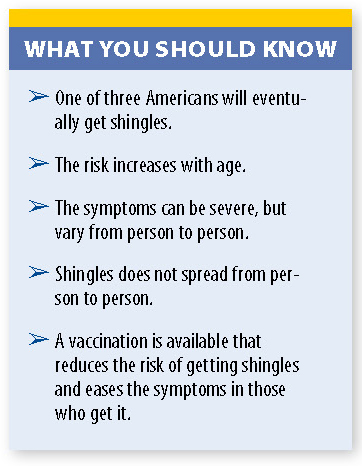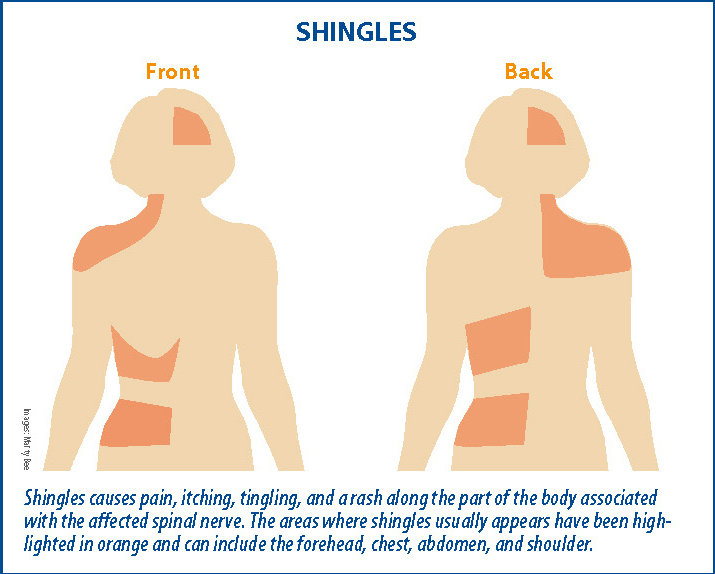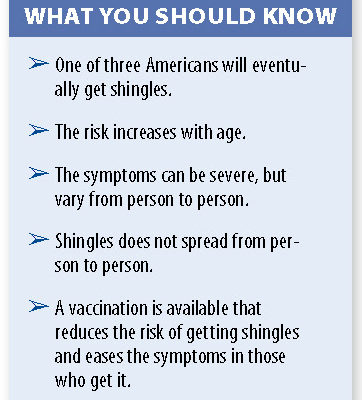The Importance of Getting a Shingles Vaccine
The older we become, the more likely we are to get shingles, a viral disease that causes a painful, blistering rash. Getting a shingles vaccine is associated with a 50 percent reduction in the risk of shingles, but only about four percent of adults over the age of 65 have had the vaccine.
 “Shingles (also known as herpes zoster) is caused by the reactivation of varicella-zoster virus, which causes chicken pox in childhood,” says Michelle Eslami, MD, a geriatrician at UCLA Health System. “Those who are over 50 years and/or have a comprised immune system are at the greatest risk for shingles. It is recommended that all patients older than 50 years be vaccinated whether they have had shingles be-fore or not.”
“Shingles (also known as herpes zoster) is caused by the reactivation of varicella-zoster virus, which causes chicken pox in childhood,” says Michelle Eslami, MD, a geriatrician at UCLA Health System. “Those who are over 50 years and/or have a comprised immune system are at the greatest risk for shingles. It is recommended that all patients older than 50 years be vaccinated whether they have had shingles be-fore or not.”
If you’ve had chickenpox, you are in a very high-risk group for eventually having shingles. After causing chickenpox, the virus becomes dormant, but it can emerge later in life as a person’s immune system weakens. Illness, trauma, and stress can make people even more susceptible.
If and when varicella-zoster reappears in the form of shingles, it takes a heavy toll. The most commonly reported symptoms are pain, sensitivity to touch, itching, numbness, and weakness. For many patients, the symptoms come on gradually with warning signs such as mild itching, tingling, burning, or moderate pain on one side of the body or face. As it progresses to full-blown shingles, the blistering rash can cause severe, stabbing pain.
“Shingles causes a painful unilateral vesicular rash along the nerve dermatomes,” Dr. Eslami says. “This nerve pain can persist even after the rash has resolved and last for months or years in some people.” For some, the pain is debilitating, but the symptoms vary widely from person to person. It usu-ally takes two to four weeks for the blisters to erupt, form scabs, and heal. Between 10 and 18 percent of peo-ple with shingles will develop postherpetic neuralgia (PHN), a painful condition that can last months to years. “Shingles is not contagious unless those around the shingles patient have never had the chicken pox or the varicella virus vaccine. They are infectious until the blisters scab,” Dr. Eslami adds.
The vaccine. The Centers for Disease Control and Prevention recommends a one-time Zostavax vaccination for people 50 and older. Zostavax can reduce the pain and complications of shingles, prevent the disease in about half of those 60 and older, and reduce the risk of PHN by more than 65 percent.
“The vaccine is thought to be effective in the majority of cases, but patients should know they can still get shingles even after having the vaccine,” Dr. Eslami cautions. “For people who have had the vaccine and still develop shingles, the rash and nerve pain complications are usually less severe and resolve sooner and in most cases, the PHN doesn’t occur.”
The consequences of not getting a shingles vaccination can be severe—recurring pain and discomfort for the rest of your life. Most health care providers and health agencies recommend that people over 50 get the shingles vaccine. It is a one-time event that could provide a lifetime of relief. While it is better to receive the shot sooner, there is no maximum age limit, so you can receive it at anytime.

The post The Importance of Getting a Shingles Vaccine appeared first on University Health News.
Read Original Article: The Importance of Getting a Shingles Vaccine »
Powered by WPeMatico


